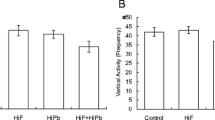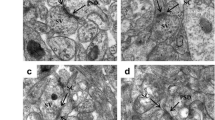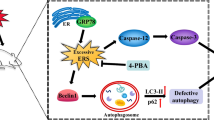Abstract
Both fluoride and lead can cross the blood-brain barrier and produce toxic effects on the central neural system, resulting in low learning and memory abilities, especially in children. In order to identify the proteomic pattern in the cortex of young animals, from the beginning of fertilization to the age of postnatal day 56, pregnant female mice and pups were administrated with 150 mg sodium fluoride/L and/or 300 mg lead acetate/L in their drinking water. Two-dimensional electrophoresis (2-DE) combined with mass spectrometry (MS) was applied to identify differently expressed protein spots. Results showed that there were eight proteins in the cortex that significantly changed, whose biological functions were involved in (1) energy metabolism (Ndufs1, Atp5h, Atp6v1b2), (2) cytoskeleton (Spna2, Tuba1a, Tubb2a), (3) glycation repair (Hdhd2), and (4) cell stress response (Hspa8). Based on the previous and current studies, ATPase, Spna2, and Hspa8 were shared by fluoride and lead both as common target molecules.



Similar content being viewed by others
References
Chai XQ, Liu JP (2007) Effects of mild lead poisoning on children’s attention and behaviors [in Chinese]. Proceeding Clin Med 16(7):611–612
Coplan MJ, Patch SC, Masters RD et al (2007) Confirmation of and explanations for elevated blood lead and other disorders in children exposed to water disinfection and fluoridation chemicals. Neurotoxicology 28(5):1032–1042
Masters RD, Coplan MJ, Hone BT et al (2000) Association of silicofluoride treated water with elevated blood lead. Neurotoxicology 21(6):1091–1100
Zhai Y, Dong J, Cao XZ et al (2006) Epidemiological investigation about the relation between blood lead level and high fluorine drinking water in children [in Chinese]. Mater Chil Health Care China 21(8):1088–1090
Ding Y, Gao Y, Sun H et al (2011) The relationships between low levels of urine fluoride on children’s intelligence, dental fluorosis in endemic fluorosis areas in Hulunbuir, Inner Mongolia, China. J Hazard Mater 186(2–3):1942–1946
Doull J, Boekelheide K, Farishian BG et al (2006) Fluoride in drinking water: a scientific review of EPA’s standards. National Academies Press, Washington
Tang QQ, Du J, Ma HH et al (2008) Fluoride and children’s intelligence: a meta-analysis. Biol Trace Elem Res 126(1–3):115–120
Trivedi MH, Verma RJ, Chinoy NJ et al (2007) Effect of high fluoride water on intelligence of school children in India. Fluoride 40:178–183
Rohlom K (1937) Fluorine intoxication: a clinical hygienic study with a review of the literature and some experimental investigations. HK Lewis, London
Yang Y, Wang X, Guo X et al (2008) The effects of high levels of fluoride and iodine on child intellectual ability and the metabolism of fluoride and iodine. Fluoride 41(4):336–339
Saxena S, Sahay A, Goel P (2012) Effect of fluoride exposure on the intelligence of school children in Madhya Pradesh, India. J Neurosci Rural Pract 3(2):144–149
Trivedi M, Sangai N, Patel R et al (2012) Assessment of groundwater quality with special reference to fluoride and its impact on IQ of schoolchildren in six villages of the Mundra region, Kachchh, Gujarat. India Fluoride 45(4):377–383
Eswar P, Nagesh L, Devarajc C (2011) Intelligence quotients of 12–14 year old school children in a high and a low fluoride village in India. Fluoride 44(3):168–172
Shivaprakash PK, Ohri K, Noorani H (2011) Relation between dental fluorosis and intelligence quotient in school children of Bagalkot district. J Indian Soc Pedod Prev Dent 29(2):117–120
Poureslami HR, Horri A, Garrusib B (2011) IQ of children age 7–9 in a high and a low F water city in Iran. Fluoride 44(3):163–167
Seraj B, Shahrabi M, Shadfar M et al (2012) Effect of high water fluoride concentration on the intellectual development of children in Makoo/Iran. J Dent (Tehran) 9(3):221–229
Rocha-Amador D, Navarro ME, Carrizales L et al (2007) Decreased intelligence in children and exposure to fluoride and arsenic in drinking water. Cad Saude Publica 23(Suppl 4):S579–587
Niu RY, Sun ZL, Wang JM et al (2008) Effects of fluoride and lead on locomotor behavior and expression of nissl body in brain of adult rats. Fluoride 41(4):276–282
Niu R, Liu S, Wang J et al (2014) Proteomic analysis of hippocampus in offspring male mice exposed to fluoride and lead. Biol Trace Elem Res. doi:10.1007/s12011-014-0117-2
Ferlemi AV, Avgoustatos D, Kokkosis AG et al (2014) Lead-induced effects on learning/memory and fear/anxiety are correlated with disturbances in specific cholinesterase isoform activity and redox imbalance in adult brain. Physiol Behav 131:115–122
Ge Y, Niu R, Zhang J et al (2011) Proteomic analysis of brain proteins of rats exposed to high fluoride and low iodine. Arch Toxicol 85(1):27–33
Wang SX, Wang ZH, Cheng XT et al (2007) Arsenic and fluoride exposure in drinking water: children’s IQ and growth in Shanyin county, Shanxi province, China. Environ Health Perspect 115(4):643–647
Vani ML, Reddy KP (2000) Effects of fluoride accumulation on some enzymes of brain and gastrocnemius muscle of mice. Fluoride 33(1):17–26
Wang H, Zhou B, Cao J et al (2009) Effects of dietary protein and calcium on thymus apoptosis induced by fluoride in female rats (Wistar rats). Environ Toxicol 24(3):218–224
Shashi A (2003) Histopathological investigation of fluoride-induced neurotoxicity in rabbits. Fluoride 36(2):95–105
Wang JD, Ge YM, Ning HM et al (2004) Effects of high fluoride and low iodine on biochemical indexes of the brain and learning-memory of offspring rats. Fluoride 37(3):201–208
Hong S, Pedersen PL (2008) ATP synthase and the actions of inhibitors utilized to study its roles in human health, disease, and other scientific areas. Microbiol Mol Biol Rev 72(4):590–641
Davies KM, Strauss M, Daum B et al (2011) Macromolecular organization of ATP synthase and complex I in whole mitochondria. Proc Natl Acad Sci U S A 108(34):14121–14126
Suzuki T, Murakami T, Iino R et al (2003) F0F1-ATPase/synthase is geared to the synthesis mode by conformational rearrangement of epsilon subunit in response to proton motive force and ADP/ATP balance. J Biol Chem 278(47):46840–46846
Perkins G, Bossy-Wetzel E, Ellisman MH (2009) New insights into mitochondrial structure during cell death. Exp Neurol 218(2):183–192
Strickland M, Juarez O, Neehaul Y et al (2014) The conformational changes induced by ubiquinone binding in the Na+-pumping NADH:ubiquinone oxidoreductase (Na+-NQR) are kinetically controlled by conserved glycines 140 and 141 of the NqrB subunit. J Biol Chem 289(34):23723–23733
Reyes-Prieto A, Barquera B, Juarez O (2014) Origin and evolution of the sodium-pumping NADH: ubiquinone oxidoreductase. PLoS One 9(5):e96696
Zanni G, Colafati GS, Barresi S et al (2013) Description of a novel TUBA1A mutation in Arg-390 associated with asymmetrical polymicrogyria and mid-hindbrain dysgenesis. Eur J Paediatr Neurol 17(4):361–365
Keays DA, Tian G, Poirier K et al (2007) Mutations in alpha-tubulin cause abnormal neuronal migration in mice and lissencephaly in humans. Cell 128(1):45–57
Kumar RA, Pilz DT, Babatz TD et al (2010) TUBA1A mutations cause wide spectrum lissencephaly (smooth brain) and suggest that multiple neuronal migration pathways converge on alpha tubulins. Hum Mol Genet 19(14):2817–2827
Koonin EV, Tatusov RL (1994) Computer analysis of bacterial haloacid dehalogenases defines a large superfamily of hydrolases with diverse specificity. Application of an iterative approach to database search. J Mol Biol 244(1):125–132
Allen KN, Dunaway-Mariano D (2004) Phosphoryl group transfer: evolution of a catalytic scaffold. Trends Biochem Sci 29(9):495–503
Kuznetsova E, Proudfoot M, Gonzalez CF et al (2006) Genome-wide analysis of substrate specificities of the Escherichia coli haloacid dehalogenase-like phosphatase family. J Biol Chem 281(47):36149–36161
Acknowledgments
This research was supported by the China National Natural Science Foundation (31101869, 31201965, and 31172376), Shanxi Province Natural Science Foundation (2012021027-5 and 2011021030-3), and Program for the Outstanding Innovative Teams of Higher Learning Institutions of Shanxi, Talent Introduction Start-up Projects of Shanxi Agricultural University (XB2010003).
Author information
Authors and Affiliations
Corresponding authors
Additional information
Ruiyan Niu and Yuliang Zhang contributed equally to this work as co-first authors.
Rights and permissions
About this article
Cite this article
Niu, R., Zhang, Y., Liu, S. et al. Proteome Alterations in Cortex of Mice Exposed to Fluoride and Lead. Biol Trace Elem Res 164, 99–105 (2015). https://doi.org/10.1007/s12011-014-0205-3
Received:
Accepted:
Published:
Issue Date:
DOI: https://doi.org/10.1007/s12011-014-0205-3




